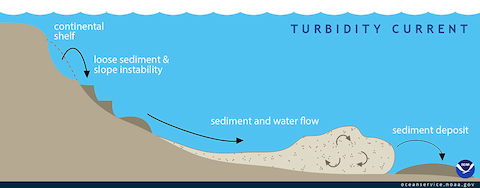
In 1858, the first transatlantic telegraph cable was laid. It worked slowly—taking 2 minutes to transmit each character of a message.
But that was a lot faster than the old way: ships, which took at least 10 days to make the journey.
That first cable failed after 3 weeks, but it showed it could be done. By 1900, there were a dozen cables connecting North America and Europe.
This ground to a halt in 1929 when all 12 cables broke in one day.
No one could figure out how it had happened. But specialized ships quickly began repair work. It took them nearly a year.
In the 1950s, scientists finally determined the culprit: a deep ocean earthquake had caused marine sediments on the slope of the continental shelf to break loose.
This created an undersea avalanche of mud and water, called a turbidity current, that raced downslope for more than 600 miles, snapping the cables as it went.
The finding encouraged operators to bury new cables beneath the seafloor to protect them.
Today more than 400 undersea fiberoptic cables traversing more than 700,000 miles carry 98 percent of international internet and trillions of dollars of financial transactions every day.
In 2020, another undersea avalanche off the Congo River delta damaged cables connecting West and South Africa. A sign that critical undersea communications are still at risk.
Background
Synopsis: Avalanches that occur under water are called turbidity currents. When unstable submarine sediments fail, they form dense sediment-water slurries that hug the ocean floor as they accelerate down continental slopes to collect in the abyss. Scientists first figured this out in 1929 when an earthquake caused a massive slump offshore Newfoundland, breaking subsea telecommunications cables progressively as the turbidity current rolled into deeper and deeper water. Since then, civilization has grown to depend almost entirely on subsea cables for global communication. In January of 2020, another turbidity current flowed for more than 2 days from near the mouth of the Congo River, breaking telecommunications cables along its 700 mi (1,130 km) path, thus exposing our continued vulnerability.
- Transatlantic communication was dramatically revolutionized in the late 1800s as message turnaround time decreased from weeks to minutes.
- Until the mid 1800s, communication between Europe and North America travelled via ship requiring a one-way journey of 10 days or longer.
- In the late 1830s, telegraph cables were laid between France and Britain, and their success led to the first transatlantic telegraph cable in 1858, which took more than two minutes to transmit each character in a message.
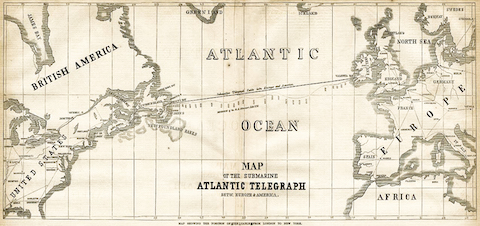
The first transatlantic submarine cable was laid in 1858, from Newfoundland, Canada to Ireland. Credit: Public Domain. - The cable failed after 3 weeks of operation, but by 1866 several transatlantic cables were operational, and by 1900 there were more than 130,000 miles (200,000 km) of cable deployed.
- By the 1920s, a dozen telegraph cables stretched across Newfoundland’s continental shelf, continental slope and abyssal plain on their way to Europe, but on November 18, 1929, everything changed.
- A magnitude 7.2 earthquake struck in 7,000 ft (2,135 m) deep water 250 mi (400 km) offshore, and the associated tsunami killed 28 people on Newfoundland’s Burin Peninsula.
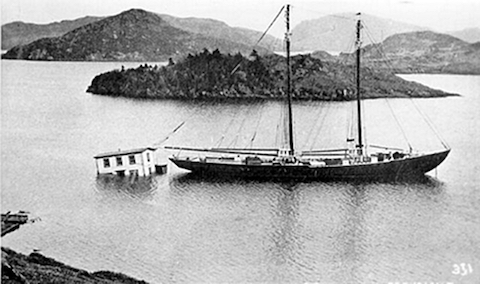
The aftermath of the 1929 Grand Banks Earthquake. This image shows the home of Steven Henry Isaacs of Port au Bras, which was towed back to shore after being swept out to sea by the tsunami and anchored to the fishing schooner Marian Belle Wolfe. Credit: Provincial Archives, Government of Newfoundland and Labrador - Communication was abruptly cut off as six of the cables broke simultaneously, and, then, over the next 13 hours and 17 minutes, the next six, each of which were progressively deeper, broke sequentially.
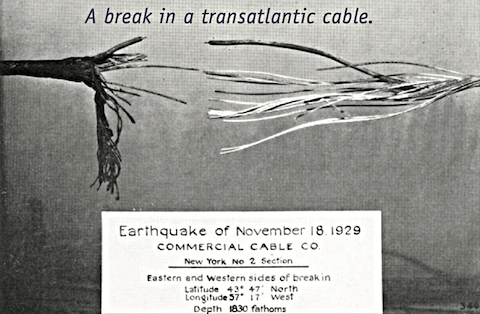
A 1929 break in one of the twelve transatlantic cables from a 10,980 ft depth. Credit: Provincial Archives, Government of Newfoundland and Labrador - At the time, no one understood what caused the cables to break in a total of 28 places and at depths of more than 10,000 ft (3050 m).
- It took every available cable ship in the Atlantic nearly a year to repair the breaks.
- A magnitude 7.2 earthquake struck in 7,000 ft (2,135 m) deep water 250 mi (400 km) offshore, and the associated tsunami killed 28 people on Newfoundland’s Burin Peninsula.
- Scientists studied the sequence of events for decades, and, then, in 1952, two scientists at Columbia University figured it out.
- Bruce Heezen and Maurice Ewing used seismic-refraction surveys to image the seafloor in the region.
- They demonstrated that an underwater landslide was initiated by the earthquake, causing the deadly tsunami as well as the cable breaks.
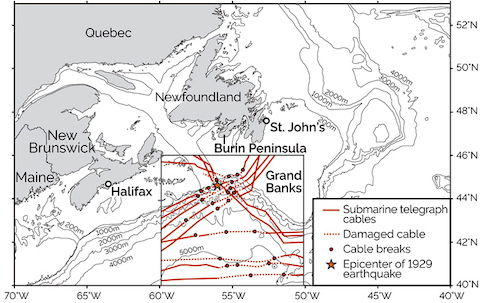
On the night of Nov. 18, 1929, a magnitude 7.2 earthquake on the Grand Banks off Newfoundland triggered a landslide-generated tsunami that killed 28 people on the Burin Peninsula and broke 12 submarine telegraph cables. The sequential breakage of six of the cables—over 13 hours and a distance of nearly 500 km—later led to the discovery of turbidity currents. Credit: K. Cantner, AGI, after Heezen and Ewing, American Journal of Science, 1952; Fine et al., Marine Geology, 2005; and Ruffman, Newfoundland and Labrador Studies, 2006. - They calculated that the turbid-density current careened at around 60 mph (100 km/h) for more than 620 mi (1,000 km) from the point of failure along the Scotian Shelf edge with peripheral slope failures feeding the avalanche for many hours.
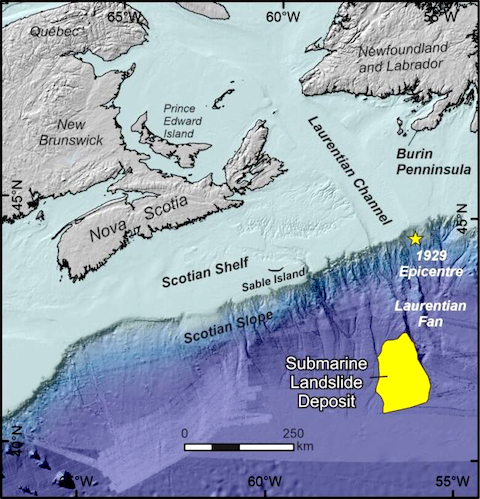
The location of the landslide deposit and the epicenter of the 1929 Grand Banks earthquake. Credit: Natural Resources Canada, via CBC.
- What is a turbidity current?
- When unstable material moves downslope swiftly it is called an avalanche.
- Slope failure may occur because of overloading or jostling of unconsolidated sediments on dipping surfaces.
- When this occurs under water, sediment laden water forms a turbid slurry that hugs the bottom of the basin because the gravity driven flow is denser than the surrounding water.
- These under water avalanches may occur in fresh or saline water bodies in response to sudden events like floods and earthquakes and are known as turbidity currents.
- Like land-based flash floods, these subsea currents tend to pick up additional sediment as they scour the basin floor, gaining momentum and speed.
- When they run out onto the flatter abyssal plain, they drop heavier sediments like gravel and sand first, with silt and mud settling slowly over the deposits.
- Because the flowing slurry violently displaces water, turbidity currents often cause tsunamis.
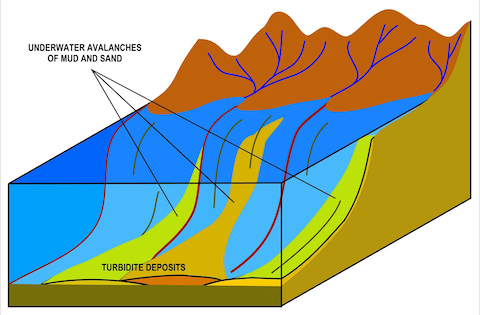
Turbidites are deposited in the deep ocean troughs below the continental shelf, or similar structures in deep lakes, by underwater turbidity currents (or underwater avalanches) which slide down the steep slopes of the continental shelf edge, as illustrated in the diagram. When the material comes to rest in the ocean trough, it is the sand and other coarse material which settles first followed by mud and eventually the very fine particulate matter. Credit: Oggmus, CC BY-SA 4.0 <https://creativecommons.org/licenses/by-sa/4.0>, via Wikimedia Commons - Many of today’s oil and gas reservoirs are ancient turbidity current deposits called turbidites.
- In the space age you may be surprised to learn that more than 98% of today’s internet communication—including cloud computing—travels via subsea fiber optic cables.
- Twenty-seven years after the Grand Banks event the first telephone cables connected Europe and America in 1956.
- Just thirty-two years later the first transatlantic fiber optic cable was laid in 1988 connecting New Jersey, the UK and France. It increased data speed tenfold to 280 megabits per second, enabling the early development of the World Wide Web. It was retired in 2002.
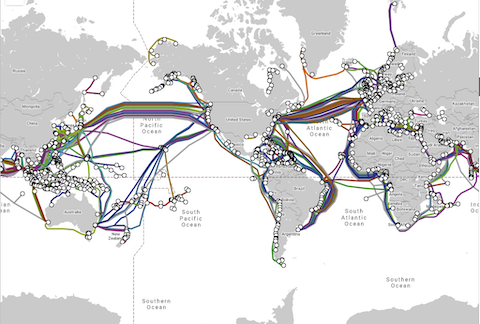
Map of submarine-communication cables as of mid 2021. Credit: Telegeography Submarine Cable Map - Today more than 420 submarine cables are in service across the globe with a combined length of more than 700,000 mi (1.1 million km). The longest to date is Google’s 3,977 mi (6400 km) line from Virginia to France.
- These communication arteries transmit data, including daily money transfers in the trillions of dollars, at speeds of more than 250 terabits per second (that is three times the entire digitized Library of Congress content every second).
- While these extremely valuable cables are buried in the seafloor to protect them from damage, recent events demonstrate that they are still very vulnerable.
- In 2020, in the Congo Canyon offshore of West Africa, scientists logged the longest duration turbidity current ever recorded on January 14–16.
- In anticipation of possible turbidity flows, scientists from the University of Durham had previously deployed buoys at increasing depths all along the submarine Congo River Canyon.
- The sensors were designed to float to the sea surface and signal researchers if their moorings were broken.
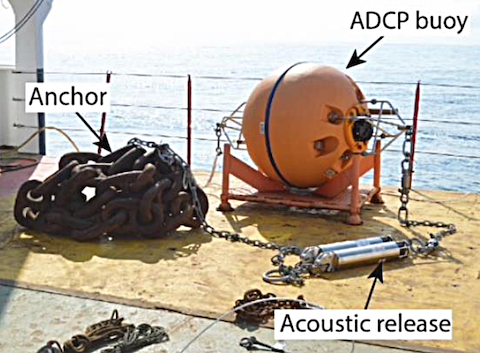
A photograph of the moorings on deck before deployments in 2019, showing the anchor, buoyant float and the two acoustic releases, which are all linked via chain or wire. Credit: Novel sensor array helps to understand submarine cable faults off West Africa | Eartharxiv - Other canyons offshore California and Canada were instrumented in the same way as part of the research.
- The sensors were designed to float to the sea surface and signal researchers if their moorings were broken.
- Heavy rains caused major flooding along the Congo River from October 2019 to January 2020, triggering a November 2019 landslide in Kinshasa, the capital of the Democratic Republic of Congo, that killed at least 41 people.
- The floods reached the river’s estuary in late December and dumped their debris at the head of the Congo Canyon, loading and oversteepening sediments on the edge of the shelf.
- Two weeks later an exceptionally low tide related to a strong spring tide event destabilized pore water pressure in the flood deposit, causing the sediment pile to fail catastrophically.
- The turbidity current accelerated for two full days through the Congo Canyon, progressively eroding more and more of the steep continental slope.
- It ultimately carried about 0.24 cu mi (1 cu km) of sediment more than 700 mi (1,130 km) onto the flat ocean floor where it spread out into an apron shaped deposit 2.8 miles (4.5 km) below sea level.
- Two submarine-communications cables that had operated continuously for 19 years on the continental slope were damaged, slowing the internet between Nigeria and South Africa for a few weeks until they were repaired.
- On March 9, 2020, a second flow initiated by a subsequent tidal event damaged one of the repaired cables, showing that these events can continue as slopes stabilize over time.
- Scientists helped telecoms crews find and repair the damaged lines using the data they collected.
- In anticipation of possible turbidity flows, scientists from the University of Durham had previously deployed buoys at increasing depths all along the submarine Congo River Canyon.
- Observation of these phenomena helps telecommunications companies to ensure these strategic communication lines are protected in the future.
- Risk of damage to future cable installations may be decreased by avoiding cable placement near inflection points along steeper slopes that tend to be erosional.
- The studies also demonstrate the potential for repetitive and long-lived events that may require prolonged repairs.
- However, natural events may not be the only concern.
- Subsea telecommunications cables are so vital to global commerce that the UK will launch a new Royal Navy ship for their strategic protection in UK and international waters in 2024.

